Discover 35 hidden attractions, cool sights, and unusual things to do in Syracuse (United States). Don't miss out on these must-see attractions: Temple Society of Concord, Rosamond Gifford Zoo, and Oakwood Cemetery. Also, be sure to include Clinton Square in your itinerary.
Below, you can find the list of the most amazing places you should visit in Syracuse (New York).
Table of Contents
Temple Society of Concord
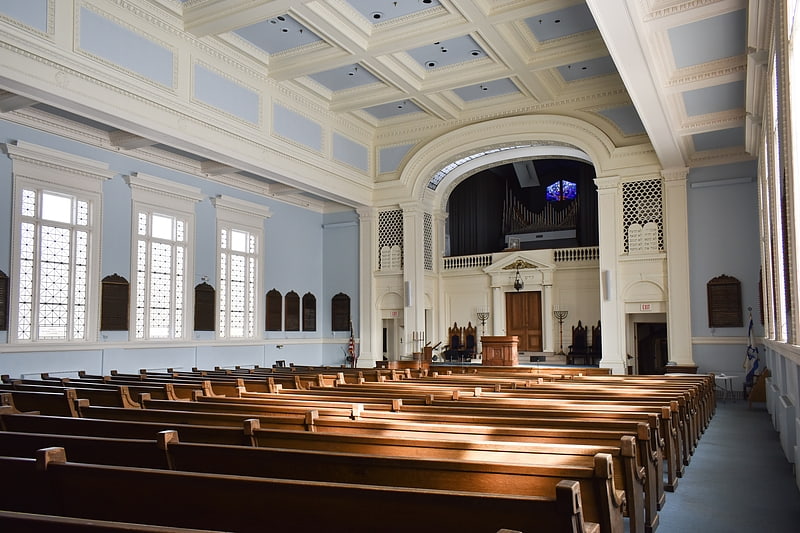
Reform synagogue in Syracuse, New York. The Temple Society of Concord, commonly referred to as Temple Concord, is a Reform Jewish congregation located at 910 Madison Street, Syracuse, in the U.S. state of New York. Established in 1839, it is the ninth-oldest still-active Jewish congregation in the United States. Temple Concord, a member of the Union for Reform Judaism, is the leading Reform synagogue in Central New York, and maintains the largest Jewish religious school in the region. Religious services are held every Friday night and Saturday morning, and on Jewish holidays. Religious school and adult education programs take place twice a week. Temple Concord is also the setting for a wide array of educational, cultural and social events the serve then entire Syracuse-area community.[1]
Address: 501 University Avenue, Syracuse (Eastside)
Rosamond Gifford Zoo
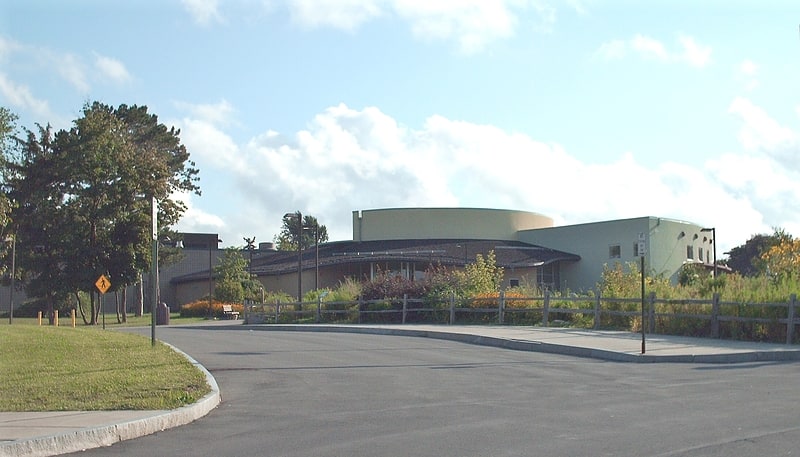
Tiny frogs to giant elephants on display. The Rosamond Gifford Zoo at Burnet Park is an AZA zoo in Syracuse, New York. It is owned and operated by Onondaga County Parks with support from the Friends of the Rosamond Gifford Zoo. The zoo is home to more than 900 animals representing 216 species on 43 acres. Some of the more popular animals include Asian elephants, Humboldt penguins, Amur tigers, a Komodo dragon and the only Giant Pacific octopus exhibit in Central New York. The zoo opened a new Animal Health Center in 2022 that is the largest zoological medical center in New York state outside of the Bronx Zoo.
The Rosamond Gifford Zoo has been a continuously accredited member of the Association of Zoos and Aquariums (AZA) since 1987.[2]
Address: 1 Conservation Pl, 13204-2590 Syracuse
Oakwood Cemetery

Cemetery in Syracuse, New York. Oakwood Cemetery is a 160-acre historic cemetery located in Syracuse, New York. It was designed by Howard Daniels and built in 1859. Oakwood Cemetery was created during a time period in the nineteenth century when the rural cemetery was becoming a distinct landscape type, and is a good example of this kind of landscape architecture.
The original 92 acres (37 ha) included about 60 acres (24 ha) of dense oak forest with pine, ash, hickory and maple. A crew of 60 laborers without large-scale earth moving equipment thinned and grouped the trees; today there are many 150-year-old specimens. Students of SUNY-ESF and Syracuse University, whose campuses are adjacent to Oakwood, can regularly be seen in the cemetery for instruction on plant species, capturing insect specimens, cemetery studies, or mammal surveys.[3]
Address: 940 Comstock Avenue, Syracuse (Eastside)
Clinton Square
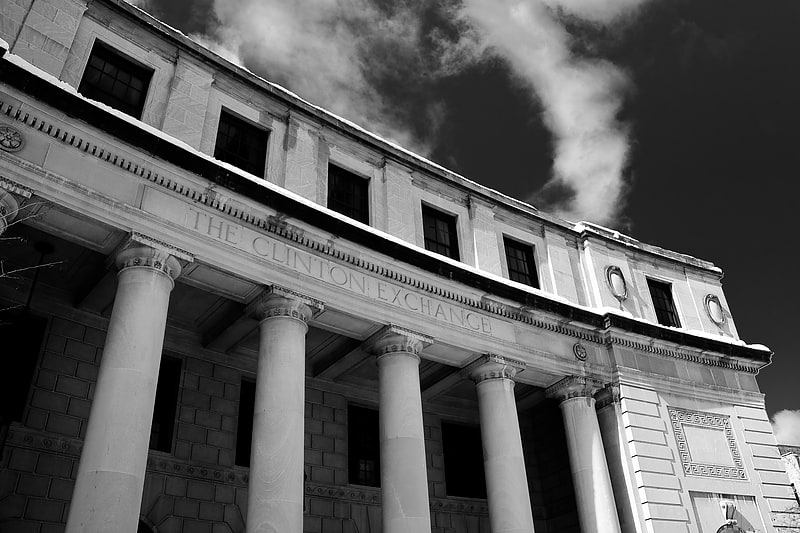
Park in Syracuse, New York. Clinton Square is an intersection in downtown Syracuse, New York, United States. The square was the original town center and first came into existence in the early 19th century where roadways from north and south convened. With the opening of the Erie Canal in 1825 the intersection was further transformed. During the 19th century, the square was a marketplace that also hosted several public events, including an 1870 public barbecue reportedly attended by 20,000 people.
As a busy intersection, the square hosted several large hotels and other historic buildings. The Soldiers and Sailors Monument was dedicated in the square in 1911. In 1917 the Canal was closed and filled in. In the decades that followed, Clinton Square was redeveloped into a park that holds various annual festivals. Since the 1990s, the square has held an ice skating rink in the winter. A major 2001 redevelopment project saw a larger fountain implemented. Clinton Square is also the site of Syracuse's municipal Christmas tree and menorah during the holiday season. The modern era has seen a number of festivals take place in the square, beginning with the 1991 Jazz Fest.[4]
Address: 161 W Genesee St, 13219-1748 Syracuse
NBT Bank Stadium
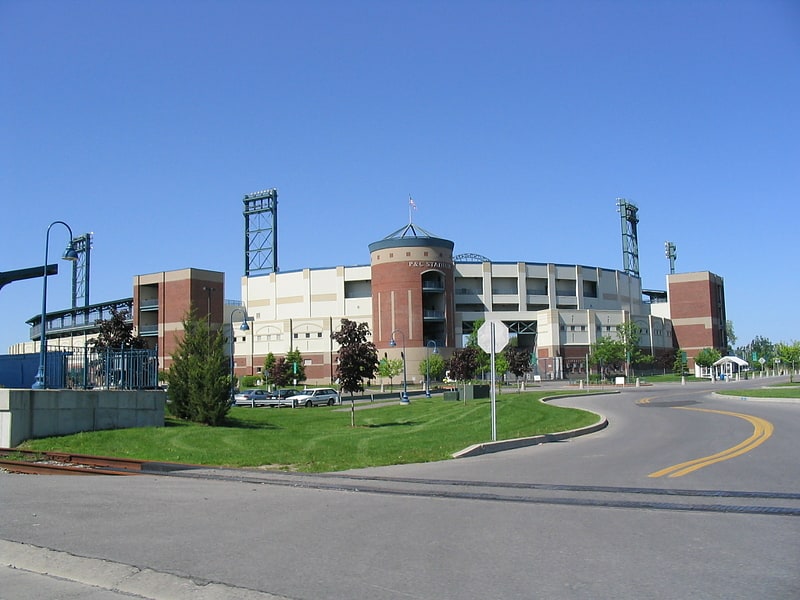
Stadium in Syracuse, New York. NBT Bank Stadium is a publicly owned, 10,815-seat, minor league baseball stadium in Syracuse, New York. It is the home stadium for the Syracuse Mets Triple-A baseball team of the International League. The stadium, owned and at times operated by Onondaga County, opened on April 10, 1997, replacing the aging MacArthur Stadium which had served as home to Syracuse's professional baseball teams since 1934 and which was demolished in 1997.[5]
Address: 1 Tex Simone Dr, 13208 Syracuse
Thornden Park
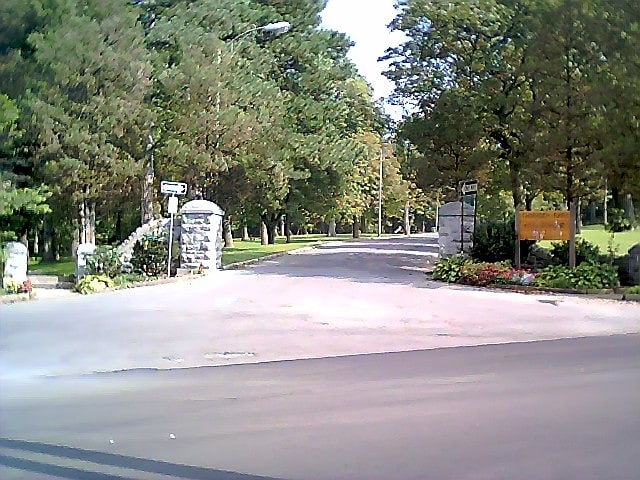
Park in Syracuse, New York. Thornden Park is a 76-acre park in Syracuse, New York, United States, which is the second largest in the city after Burnet Park. It was purchased by the city in 1921 and has become a favorite wedding location in the Syracuse park system. It is located in Westcott, and borders the University and University Hill neighborhoods. The park was listed on the National Register of Historic Places in 1994 as part of the Historic Designated Landscapes of Syracuse, New York.[6]
Address: Thornden Park Dr, 13210 Syracuse (Eastside)
Landmark Theatre
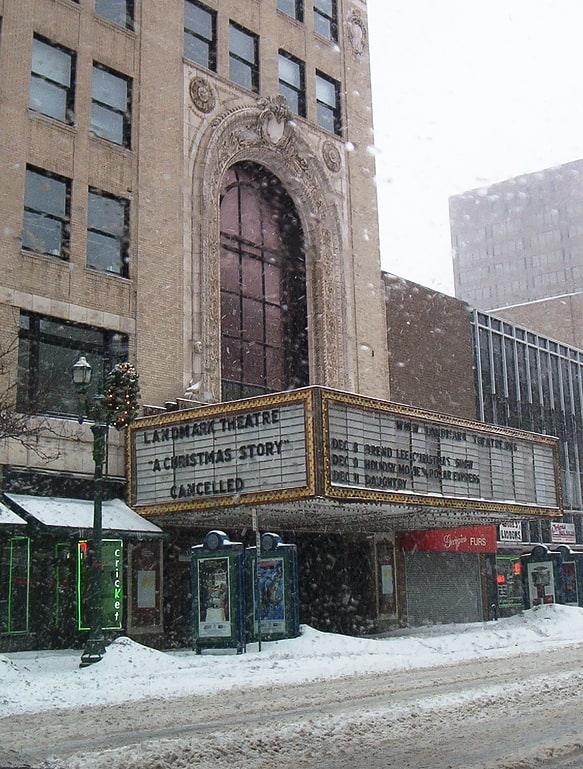
Theater in Syracuse, New York. The Landmark Theatre, originally known as Loew's State Theater, is a historic theater from the era of movie palaces, located on South Salina Street in Syracuse, New York, United States. Designed by Thomas W. Lamb, it is the city's only surviving example of the opulent theatrical venues of the 1920s. The Landmark is on the National Register of Historic Places.[7]
Address: Syracuse, 362 S. Salina Street
Erie Canal Museum
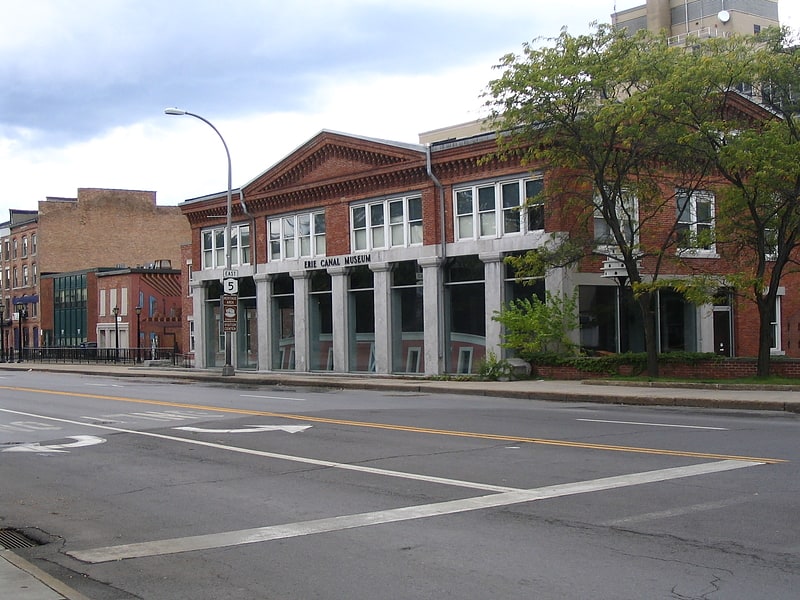
Museum in Syracuse, New York. The Erie Canal Museum is a historical museum about the Erie Canal located in Syracuse, New York. The museum was founded in 1962 and is a private, non-profit corporation. It is housed in the Syracuse Weighlock Building dating from 1850. The Syracuse Weighlock Building was in operation as a weighlock from 1850 to 1883. In 1883 the canal decided to stop charging tolls. The weighlock building was essentially used as a big, elaborate scale to weigh the boats traveling on the Erie Canal and determine how much each boat would pay for a toll. Today the museum includes not only artifacts from the Erie Canal, but also a gallery of present canal life. It is the mission of the museum to help people to learn the rich history of the Erie Canal and that it is not just a thing of the past, but still very much exists today in different forms.
The museum's Weighlock Building was listed on the National Register of Historic Places in 1971.[8]
Address: 318 Erie Blvd E, 13202-1106 Syracuse
Cathedral of the Immaculate Conception
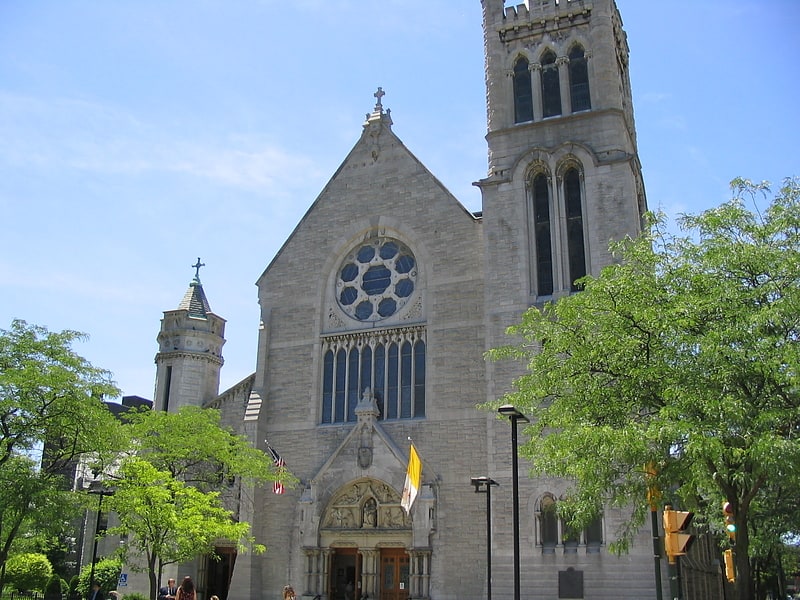
Cathedral in Syracuse, New York. The Cathedral of the Immaculate Conception in Syracuse, New York is the mother church of the Roman Catholic Diocese of Syracuse. It is the seat of the Bishop of Syracuse, currently Douglas Lucia.[9]
Address: 259 E Onondaga St, 13202 Syracuse
Everson Museum of Art
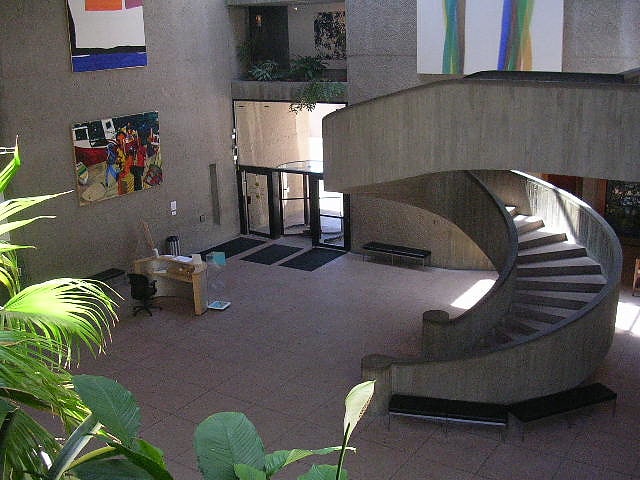
Museum in Syracuse, New York. The Everson Museum of Art in Downtown Syracuse, New York is a major Central New York museum focusing on American art.[10]
Address: 401 Harrison St, 13202-3019 Syracuse
Milton J. Rubenstein Museum of Science and Technology

Museum in Syracuse, New York. The Milton J. Rubenstein Museum of Science and Technology is a science and technology museum located in the Armory Square neighborhood of Downtown Syracuse, New York. The Museum includes 35,000 square feet of permanent and traveling exhibits, Science Shop, and several programs and events. The MOST is located in the former Syracuse Armory.
Permanent exhibits include: Innovation Station, Dino Zone!, Earth Science Discovery Cave, Upstate Medical University Life Sciences, Lockheed Martin Flight & Space, Science Playhouse, Technotown, National Grid Energy: Powering Our Future, Climbing Wall and Ham Radio Station.
The MOST will be opening a brand new domed theatre, planetarium, and media lab in April 2022, formerly known as the Bristol IMAX Omnitheatre.[11]
Address: 500 S Franklin St, 13202-1245 Syracuse
James Pass Arboretum
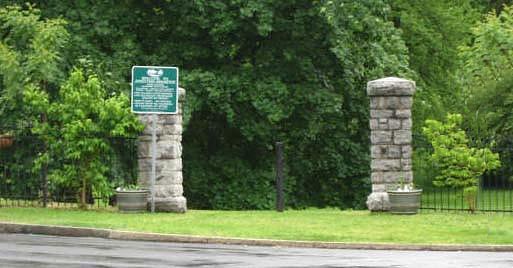
Park in Syracuse, New York. The James Pass Arboretum was established by the City of Syracuse, New York through the philanthropy of Adelaide Salisbury Pass and family with the guidance and cooperation of the State College of Forestry to be a classic arboretum in the tradition of the Arnold Arboretum in Boston MA, that is, a museum of woody plants designed for education and horticultural display.[12]
Central New York Regional Market

Farmers' market in Syracuse, New York. The Central New York Regional Market, located on the north side of Syracuse, New York, is a hybrid, public-private, retail-wholesale, terminal food market complex. In 2010, the market estimated that it had a hand in hosting sales of nearly $70 million per year in farm products.
Operated by the state-established Central New York Regional Market Authority, the market has stayed at its current location since first opening for business under the government's umbrella in 1938. Its main entrance is a roadway that is today designated Farmers' Market Place, located at 2100 Park Street, immediately opposite the mouth of the Exit 23 ramp from Interstate Route 81 northbound. The market area can also be accessed via other curb cuts along Park Street, as well as via roadways NBT Bank Parkway and Tex Simone Drive which have been set up in modern times to serve both the market and its neighbors, the William F. Walsh Regional Transportation Center, and NBT Bank Stadium.[13]
Address: 2100 Park St Ste 3, 13208-1097 Syracuse
Syracuse City Hall
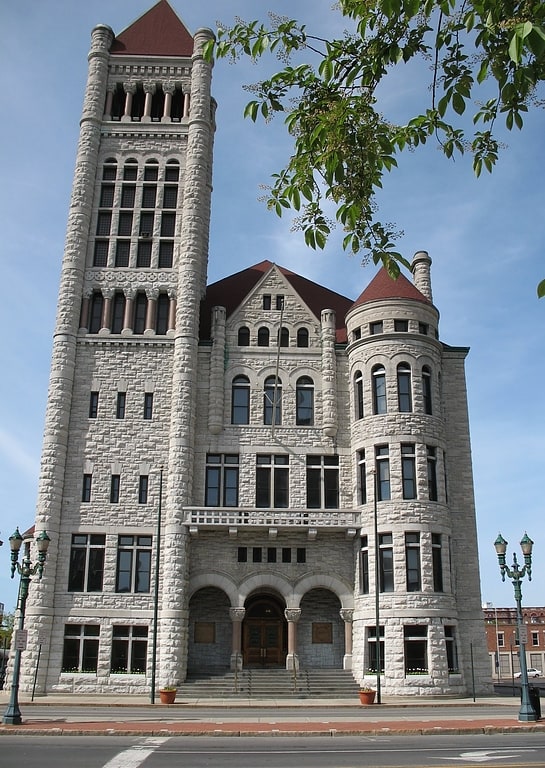
Building in Syracuse, New York. The Syracuse City Hall is the city hall of Syracuse, New York.
Unusually for civic buildings in the United States, it was constructed from 1889 to 1893 in the Romanesque Revival architectural style. The bid accepted for the construction was for $238,750.00 from Hughes Brothers of Syracuse.[14]
Address: 233 E Washington St, Syracuse
Onondaga Park
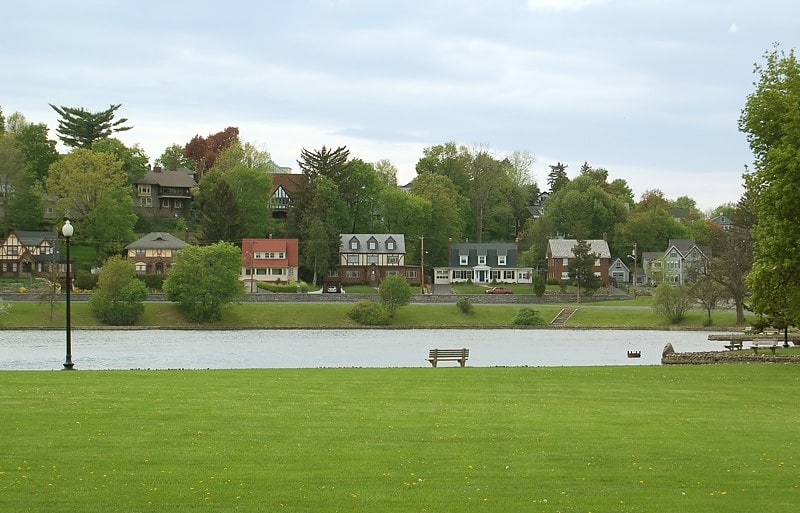
Park in Syracuse, New York. Onondaga Park is an 82.6-acre park in the city of Syracuse, New York. Man-made Hiawatha Lake is located within the park, which is situated in Syracuse's Strathmore neighborhood on the city's south side.
Portions of the park were designed by famed urban planner George Kessler in the early 20th century. The park was placed on the National Register of Historic Places in 2002.[15]
Address: Onondaga park drive, 13207 Syracuse (Southside)
The Westcott Theater
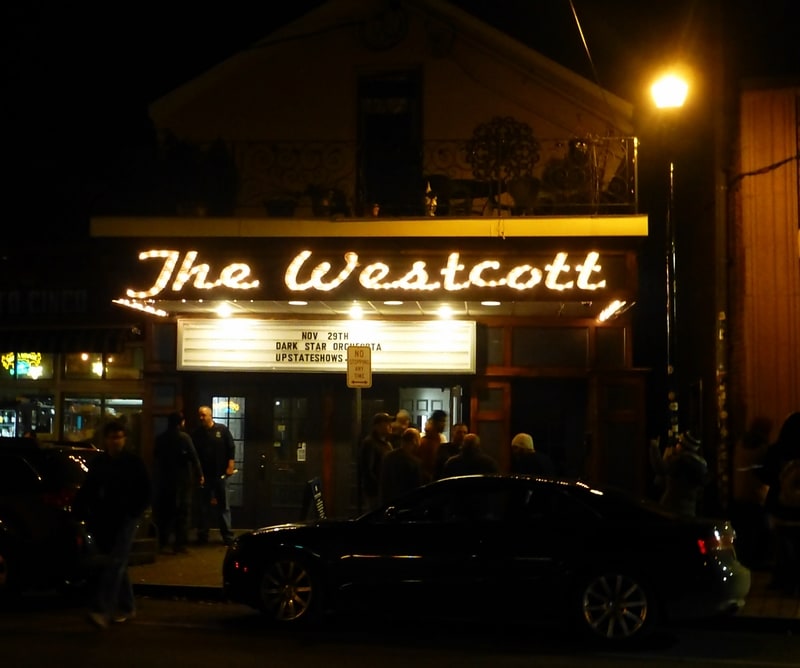
Concert venue in Syracuse, New York. The Westcott Theater is a 700-person multi-purpose, cinema-style concert venue at 524 Westcott St in the Westcott neighborhood of Syracuse, New York, United States. Although it books acts of many different genres, the venue has been steadily increasing its amount of electronic music acts since 2011. Formerly known as the Westcott Cinema, it was re-purposed and re-opened in Oct. 18, 2007 to serve as a local concert venue for the Westcott Nation as well as attract much of the Syracuse University and the State University of New York College of Environmental Science and Forestry concert going college crowd.[16]
Address: Syracuse, 524 Westcott St. Syracuse, NY 13210
Lakeview Amphitheater
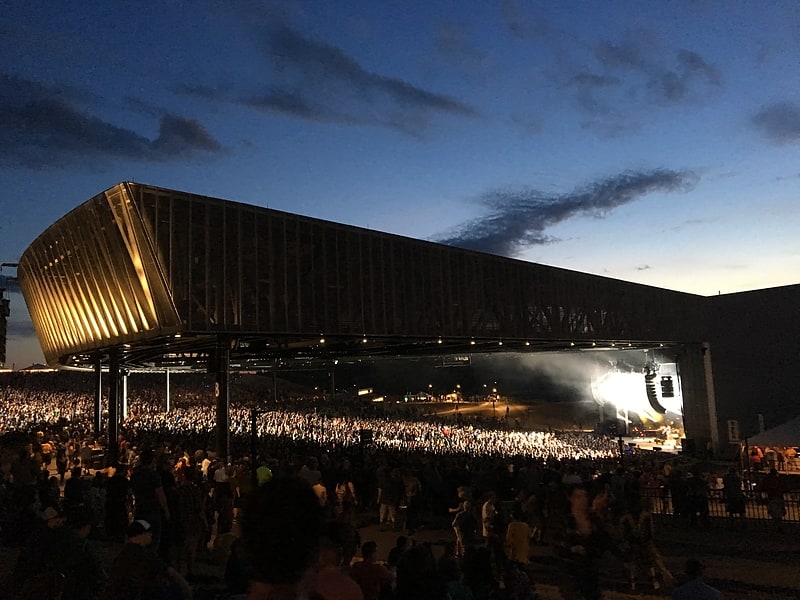
Concert hall in Syracuse, New York. The St. Joseph's Health Amphitheater is an outdoor concert venue located on the shores of Onondaga Lake in the Town of Geddes, near the western edge of Syracuse, New York. It is an extension of the Empire Expo Center, home to the Great New York State Fair.
It replaced the aging Mohegan Sun Grandstand and is the main stage for concerts during the fair season. It holds 17,500 spectators.[17]
Address: Syracuse, 490 Restoration Way, Syracuse, NY 13209-1047
Onondaga Lake
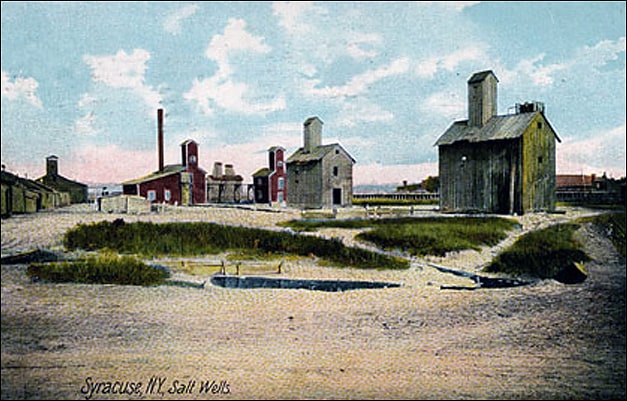
Lake in New York State. Onondaga Lake is a lake in Central New York, immediately northwest of and adjacent to Syracuse, New York. The southeastern end of the lake and the southwestern shore abut industrial areas and expressways; the northeastern shore and northwestern end border a series of parks and museums.
Although it is near the Finger Lakes region, it is not traditionally counted as one of the Finger Lakes. Onondaga Lake is a dimictic lake, meaning that the lake water completely mixes from top to bottom twice a year. The lake is 4.6 miles long and 1 mile wide making a surface area of 4.6 square miles. The maximum depth of the lake is 63 feet with an average depth of 35 feet. Its drainage basin has a surface area of 642 square kilometers, encompassing Syracuse, Onondaga County except the eastern and northern edges, the southeastern corner of Cayuga County and the Onondaga Nation Territory, and supports approximately 450,000 people.
Onondaga Lake has two natural tributaries that contribute approximately 70% of the total water flow to the lake. These tributaries are Ninemile Creek and Onondaga Creek. The Metropolitan Syracuse Wastewater Treatment Plant (METRO) contributes 20% of the annual flow. No other lake in the United States receives as much of its inflow as treated wastewater. The other tributaries, which include Ley Creek, Seneca River, Harbor Brook, Sawmill Creek, Tributary 5A, and East Flume, contribute the remaining 10% of water flow into the lake. The tributaries flush the lake out about four times a year. Onondaga Lake is flushed much more rapidly than most other lakes. The lake flows to the northwest and discharges into Seneca River which combines with the Oneida River to form the Oswego River, and ultimately ends up in Lake Ontario.
The lake is considered sacred within the indigenous territory of the Onondaga Nation. The Onondaga people had control of the lake taken from them by New York state following the American Revolutionary War. During the late 19th century, European-Americans built many resorts along the lake's shoreline, as it was a destination of great beauty. The Onondaga Nation continues to have a religious and cultural presence on the shores of the lake, today.
With the industrialization of the region, much of the lake's shoreline was developed; domestic and industrial waste, due to industry and urbanization, led to the severe degradation of the lake. Unsafe levels of pollution led to the banning of ice harvesting as early as 1901. In 1940, swimming was banned, and in 1970 fishing was banned due to mercury contamination. Mercury pollution is still a problem for the lake today. Despite the passage of the Clean Water Act in 1973 and the closing of the major industrial polluter in 1986, Onondaga Lake remained one of the most polluted lakes in the United States until several initiatives, including a 15-year multi-stage program completed in late 2017, allowed the lake to reach criteria required by the New York State Department of Environmental Conservation and the United States Environmental Protection Agency. This includes implementing a long-term operation, maintenance, and monitoring program to ensure the effectiveness of the remedy.[18]
Basilica of the Sacred Heart of Jesus
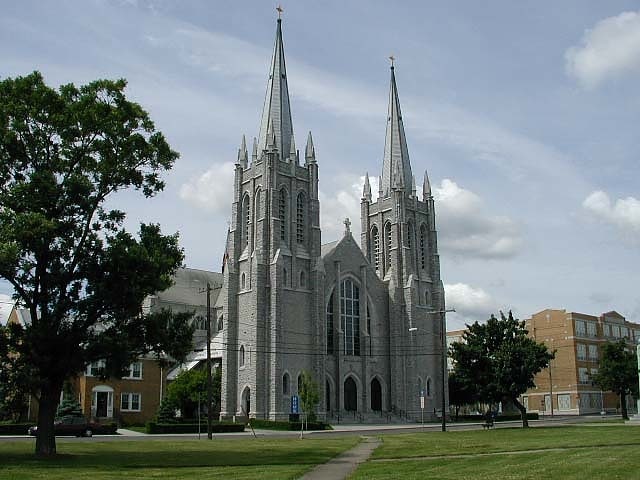
Basilica in Syracuse, New York. The Basilica of the Sacred Heart of Jesus is a Catholic parish church and minor basilica in Syracuse, New York. It is located at 927 Park Avenue in the Westside neighborhood. The building was designated a minor basilica by Pope John Paul II on August 27, 1998 and dedicated on October 3, 1999.[19]
Address: 927 Park Ave, 13204-2189 Syracuse
Westcott Community Center
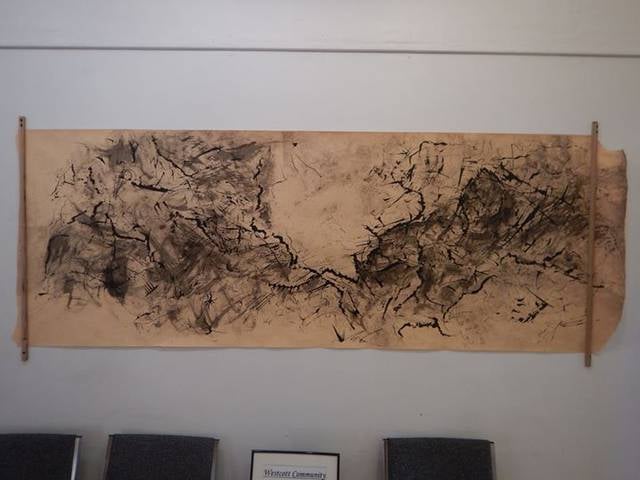
Museum, Art gallery, Event space
Address: 801-899 Westcott St, 13210 Syracuse (Eastside)
Grace Episcopal Church

Building in Syracuse, New York. Grace Episcopal Church is an historic Episcopal parish in Syracuse, New York. The Gothic Revival building was designed by Horatio Nelson White and was built in 1876. It is located at 819 Madison Avenue near Syracuse University. On March 20, 1973, it was listed on the National Register of Historic Places.[20]
Address: 819 Madison St, 13210-1736 Syracuse (Eastside)
Forman Park
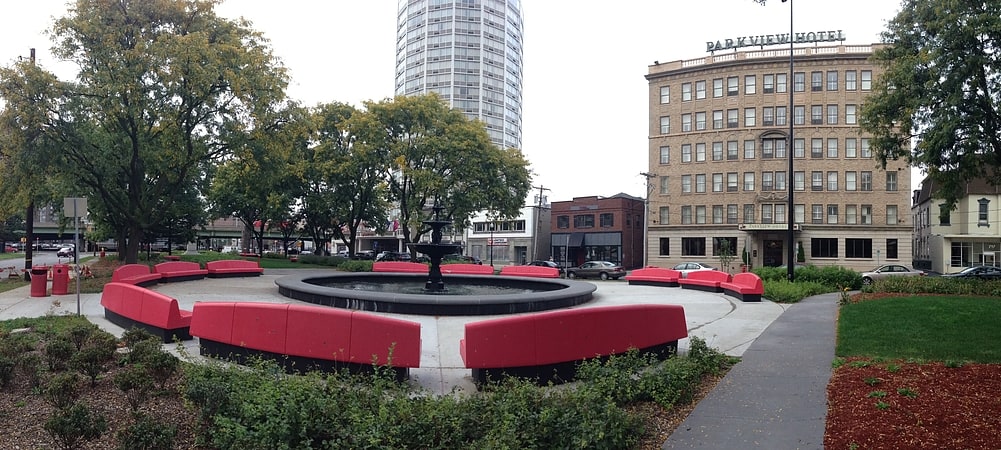
Park in Syracuse, New York. Forman Park, in Syracuse, New York, was first established on June 16, 1839 and was known as Forman Square. The main attraction is a bronze memorial of early civic leaders, Joshua Forman and Lewis H. Redfield.
Forman Park was first named Forman Square and was declared a public park in 1839 by the Trustees of the village of Syracuse.[21]
Onondaga Historical Association

Museum, Specialty museum, History museum, Art gallery
Address: 321 Montgomery St, 13202-2098 Syracuse
Saint Paul's Episcopal Cathedral
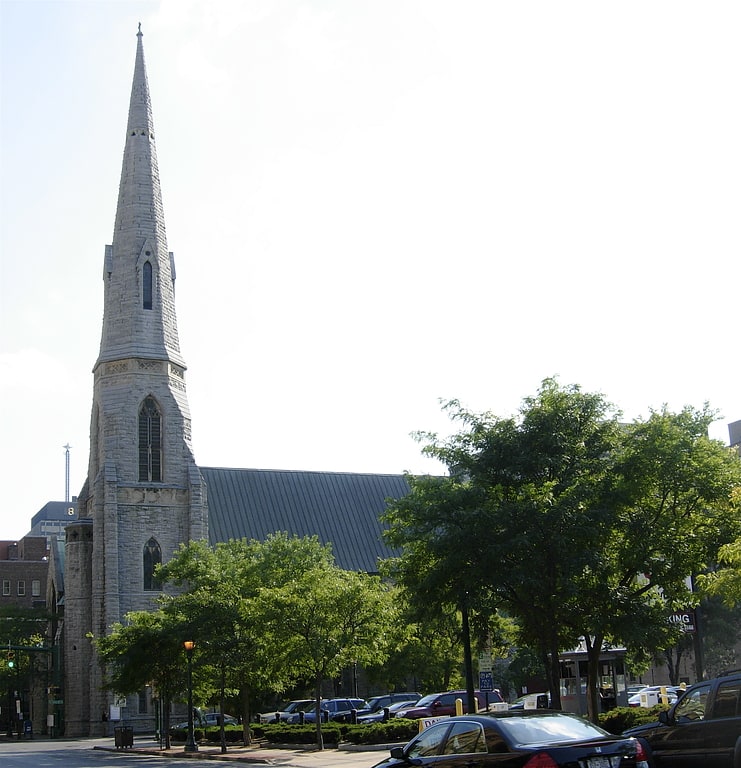
Episcopal church in Syracuse, New York. St. Paul's Cathedral in Syracuse, New York was designed by Henry Dudley, who worked with Frank Wills until Wills' early death in 1857.
The church is located at 310 Montgomery Street in downtown Syracuse.[22]
Address: 310 Montgomery St, 13202-2096 Syracuse
Plymouth Congregational Church
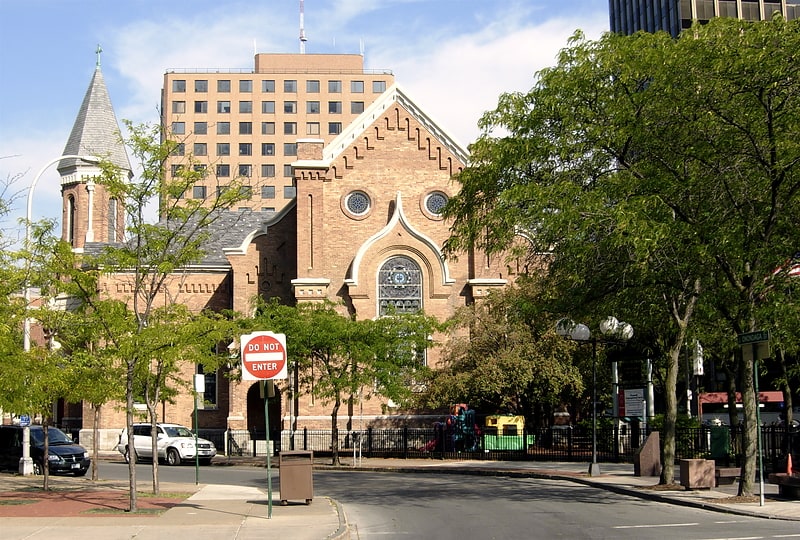
Church in Syracuse, New York. Plymouth Congregational Church is located on East Onondaga Street in Syracuse, New York. It was designed in 1858 by Horatio Nelson White in the Romanesque Revival style. The founding congregation was closely associated with the abolitionist movement in Syracuse. It was listed on the National Register of Historic Places in 1997.[23]
Address: 232 E Onondaga St, 13202-2612 Syracuse
Elmwood Park
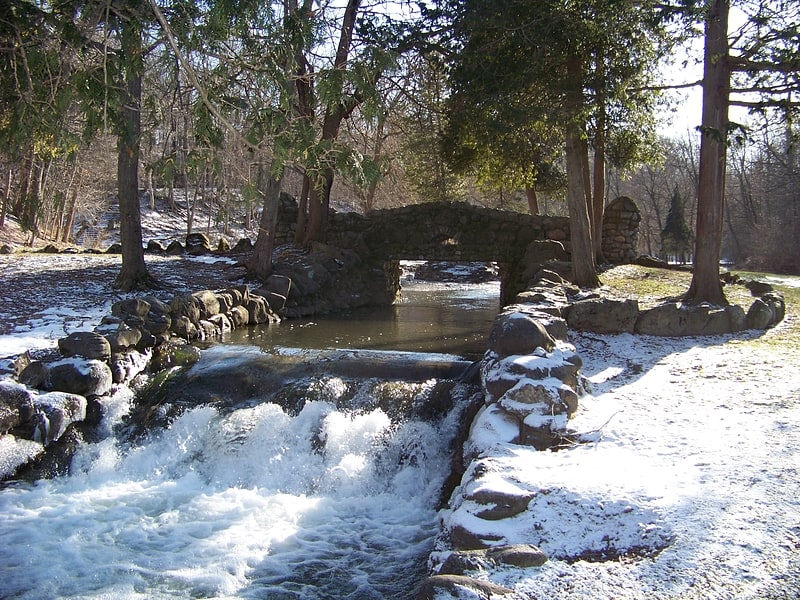
Park in Syracuse, New York. Elmwood Park is located in the southwestern portion of Syracuse, New York. The park was originally built and opened as a privately owned park in 1893. It is significant as an example of such parks from the Pleasure Ground Era. After the site was purchased by the city of Syracuse in 1927, bridges, embankments, walls and stairs built of wood and stone were added, making the park also representative of the Reform Park Era. The park was added to the National Register of Historic Places in 2005.[24]
Address: Glenwood Ave., 13210 Syracuse (Southside)
Palace Theatre
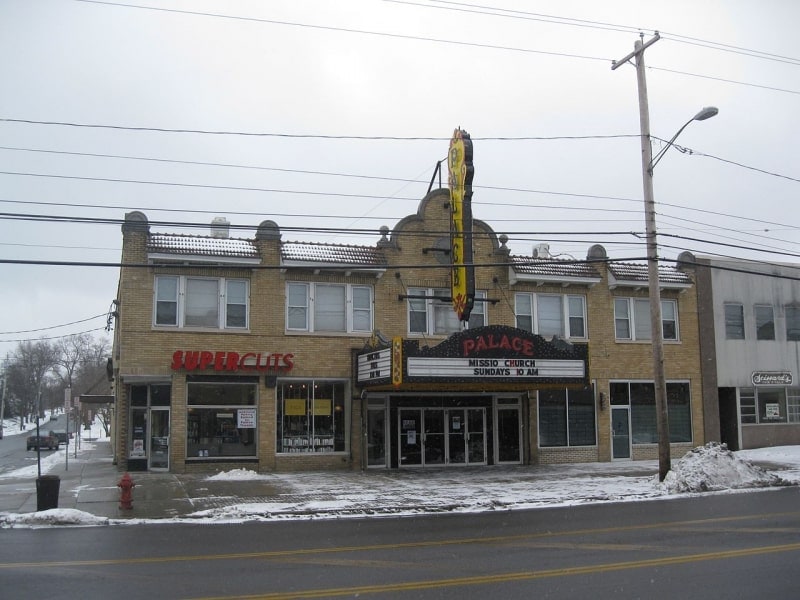
Movie theater in Syracuse, New York. The Palace Theatre is a 1920s-era movie palace in the village of Eastwood in Syracuse, New York. It has been owned and operated by the same family for more than 80 years.[25]
Address: 2378 James St, 13206-2841 Syracuse
Tipperary Hill Heritage Memorial
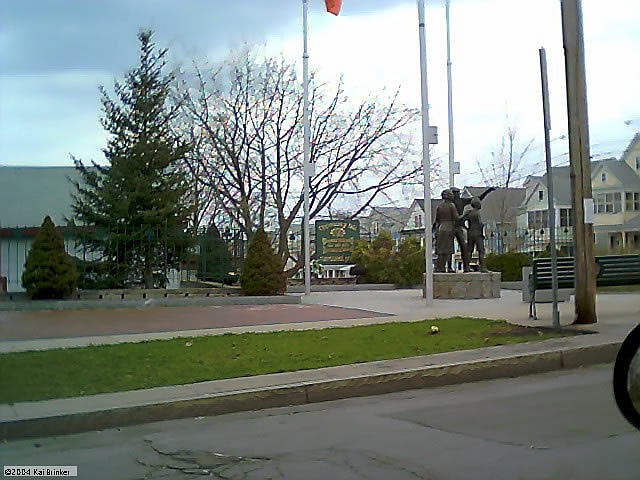
Monument in Syracuse, New York. The Tipperary Hill Heritage Memorial, dedicated in 1997, is located on Tipperary Hill in Syracuse, New York. The memorial was erected in honor of early citizens who, in the opinion of local residents, were brave sons of Ireland who stood up to City Hall and won the battle of the "Green over Red" traffic light.
The memorial features bronze, life-size figures of a 1930s Irish immigrant family and was sculpted by Dexter Benedict of Penn Yan, New York. The father is pointing out the traffic light to his wife, daughter and son who has a sling shot in his back pocket, hinting that he might know a little bit of the history of the light.
The memorial is located in Tipperary Hill Memorial Park which was originally the site of a commercial building that held a prominent position on the northeast corner of Milton Avenue and Tompkins Street and was later demolished. It is the newest city park in Syracuse.[26]
Downtown Syracuse
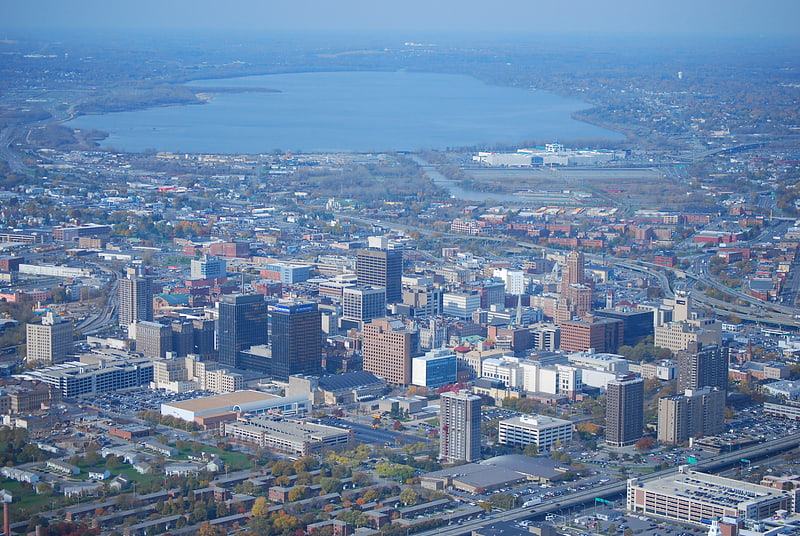
Downtown Syracuse is the economic center of Syracuse, New York, and Central New York, employing over 30,000 people, and housing over 4,300.
It is also one of the 26 officially recognized neighborhoods of Syracuse.[27]
Hall of Languages
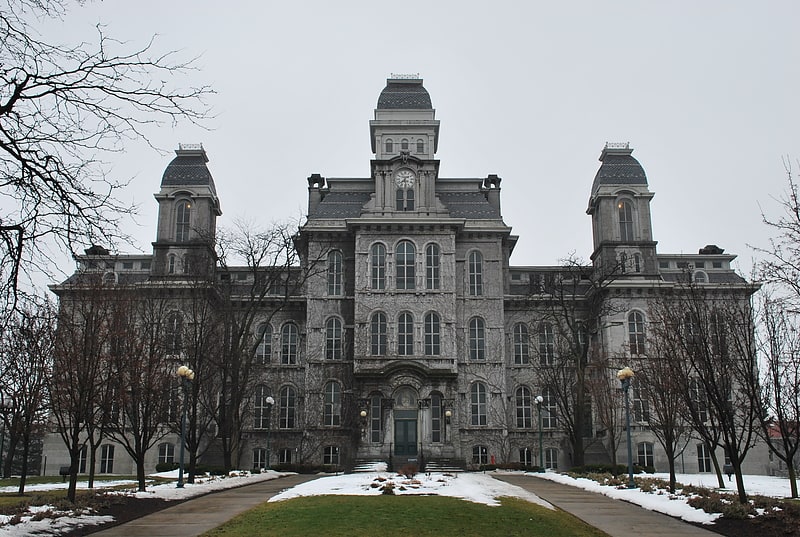
The Hall of Languages is a Syracuse University building designed by Horatio Nelson White in the Second Empire architectural style, and built in 1871–73. It was the first building constructed on the Syracuse University campus and the building originally housed the entire university.
Building's cornerstone was laid on August 31, 1871 by Jesse Truesdell Peck and the building was dedicated on May 8, 1873 by Edmund S. James, then Bishop of the New York Conference. It is styled after the Gridley Building in Downtown Syracuse, which was also designed by the same architect. It features three large towers or cupolas and is made of Onondaga limestone and wood framing with interior cast-iron columns. The original building consisted of the east and west towers only; in 1886 the central tower was added. It was originally home to the College of Liberal Arts (now defunct), and subsequently the College of Arts and Sciences.
It was listed on the National Register of Historic Places in 1973. The interior was completely rebuilt in 1978–79.
The iconic building has been prominently displayed as a representation of the University in many forums. The building served as creative inspiration for the Addams Family home in the TV show. Most recently starting in 2010 the Syracuse Orange men's basketball team started wearing NIKE jerseys that feature an aerographic of the Hall of Languages.[28]
Crouse College
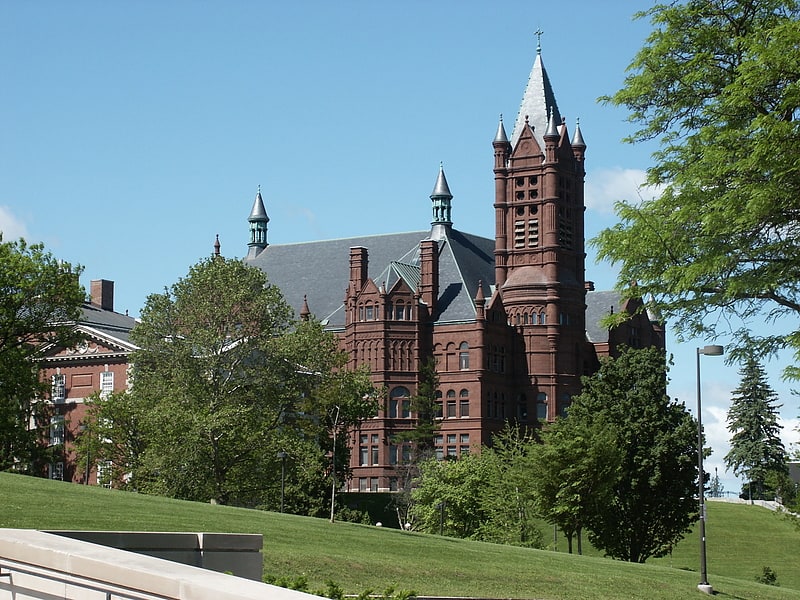
Building in Syracuse, New York. Crouse College, also known as Crouse Memorial College and historically as John Crouse Memorial College for Women, is a building on the Syracuse University campus. It was funded by John R. Crouse, a wealthy Syracuse merchant with the White family, and designed by Archimedes Russell. It is built in the Romanesque revival—Richardsonian Romanesque style.
The building was listed on the National Register of Historic Places in 1974. It is also one of the historical Comstock Tract buildings on the Syracuse campus. It currently houses Syracuse University's College of Visual and Performing Arts. Chiefly, its classrooms and auditorium are at the service of the Setnor School of Music.[29]
Islamic Society of Central New York
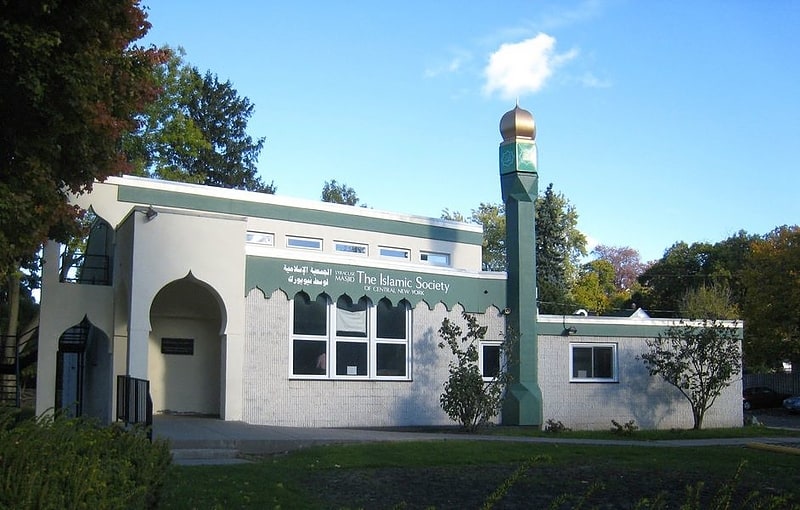
Mosque in Syracuse, New York. The Islamic Society of Central New York is a "purpose-built" Sunni mosque and Islamic community centre located on Comstock Avenue in Syracuse, NY. Founded in 1981, by Khaja Qutubuddin, the center serves the needs of Central New York's estimated 15,000 - 20,000 Muslims providing various services and outreach programs for the Muslim and non-Muslim community. It also runs an Islamic cemetery and the Madrasat Al Ihsan/School of Excellence on West Onondaga Street. The mosque is served by a full-time Imam and is administered by an elected Shura Council.
The mosque is home to a diverse congregation. Over a quarter of the mosque's congregants are African-Americans, one quarter Arabs and one fifth represent South Asia. The remainder are from various parts of the world, with European Muslims (primarily immigrants from Bosnia and Herzegovina and Kosovo, and a much smaller group of White American converts) making up approximately 5% of mosque attendees. Between one and two thirds of the community is estimated to be foreign born.[30]
Address: 925 Comstock Ave, Syracuse (Eastside)
Burnet Park

Park in Syracuse, New York. Burnet Park is the largest park in Syracuse, New York, USA, covering an area of 88 acres. It is located on the west end of the city, in the Far Westside in a neighborhood called Tipperary Hill.[31]
Long Branch Park
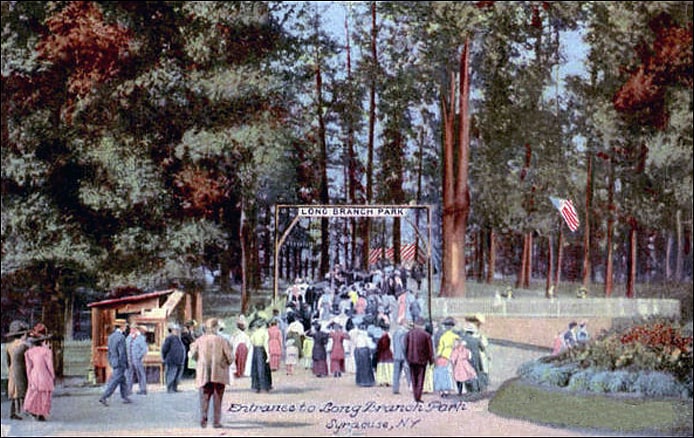
Park in Onondaga County, New York. Long Branch Park is a public park in Onondaga County outside of Syracuse, New York, located in the town of Geddes, New York on Long Branch Road near NYS Route 370 and John Glenn Boulevard. The park is situated on the northern shore of Onondaga Lake and is often misidentified as an extension of Onondaga Lake Park which wraps around the eastern shore of the lake to the south shore.
Founded in 1882 by Ben and George Maurer, Long Branch Amusement Park was originally an amusement park with boxing arenas, an arcade and a trolley. The amusement park closed in 1938.
Syracuse's largest mall, Destiny USA is located to the south of the lake and features an original carousel #18 from the amusement park.[32]
Address: 347 Long Branch Rd, 13209 Syracuse
Niagara Mohawk Building

Building in Syracuse, New York. The Niagara Mohawk Building is an art deco classic building in Syracuse, New York. The building was built in 1932 and was headquarters for the Niagara Mohawk Power Corporation, what was "then the nation's largest electric utility company". The company has since been acquired by merger into National Grid plc. It was listed on the National Register of Historic Places as the Niagara Hudson Building in 2010.
According to the National Park Service:
The Niagara Hudson Building in Syracuse is an outstanding example of Art Deco architecture and a symbol of the Age of Electricity. Completed in 1932, the building became the headquarters for the nation’s largest electric utility company and expressed the technology of electricity through its modernistic design, material, and extraordinary program of exterior lighting. The design elements applied by architects Melvin L. King and Bley & Lyman transformed a corporate office tower into a widely admired beacon of light and belief in the future. With its central tower and figurative winged sculpture personifying electric lighting, the powerfully sculpted and decorated building offered a symbol of optimism and progress in the context of the Great Depression.
The building was listed on the United States National Register of Historic Places in June 2010. The listing was announced as the featured listing in the National Park Service's weekly list of June 25, 2010. It was nominated by New York State's Board of Historic Preservation for listing on the National Register of Historic Places in December 2009. The Board described the building as "'an outstanding example of Art Deco architecture and a symbol of the Age of Electricity.'"[33]